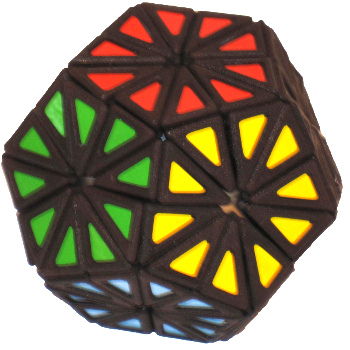
Above:Version 1
Click a thumbnail to see its larger version and description.
The holy grail of twisty puzzles. A 120-piece twisty puzzle which still has to find a good implementation.
The name Big Chop was introduced by Bram Cohen.
The Big Chop is the deepcut edge turning dodecahedron which means it is the sixth and so far only missing deepcut puzzle of all basic six axis systems.
There have been many attempts to design this puzzle but so far no one was satiyfying. Two are presented here:
Attempt 1:
In 2009 the concept of this was given as a challenge to Oskar van Deventer by Bram Cohen. Being unable to design a regular twisty-puzzle mechanism, Oskar tried a ball+magnets mechanism. Each of the 120 pieces has three magnets, so there are a whopping 360 magnets in total. The steel ball inside makes the puzzle very heavy, over 1 kilogram. The puzzle is rather awkward to play. When turning, pieces misalign and jump out. Oskar reduced the problem by introducing a cage, which is used to turn two halfs. Still, a single 180-degree turn can take over 30 seconds to complete.
Attempt 2:
In 2012 Jason Smith tried a new concept he calls "Stochastic Rails".
His version of the Big Chop consists of 60 identical copies of 2 parts. Each part would have one shell or rail at the same level. When two parts near each other, they collide and one randomly goes up while the other randomly goes down.
In the beginning of November 2012 Jason has designed 6 different pieces. None of them lead to a result Jason was satisfied with.
If it were successfully implemented the puzzle would have 576990221086735801796034753752191543786610230415663802759437338529367082431389144856549058834900528204123296277839635969745972539424768000000000000000000000000000 = 577*10^159 permutations if all pieces are considered distinguishable and their orientations visible.
Compared with the number available if the puzzle can be disassembled and reassembled there are these restrictions:
-The triangles fall into two separate sets.
-The triangles allow only even permutations.
Stickered as shown here the puzzle has 72580264675216574542125432434605479907486199169760824190077925469462908444164835104383778938186498772440186880000 = 72.6 *10^111 permutations.
Links

Contributors
Thank you to the following people for their assistance in helping collect the information on this page: Oskar van Deventer, Roxanne, beeedy, sausage.
Collections
This puzzle can be found in collections of these members:
Found a mistake or something missing?
Edit it yourself or
contact the moderator.





